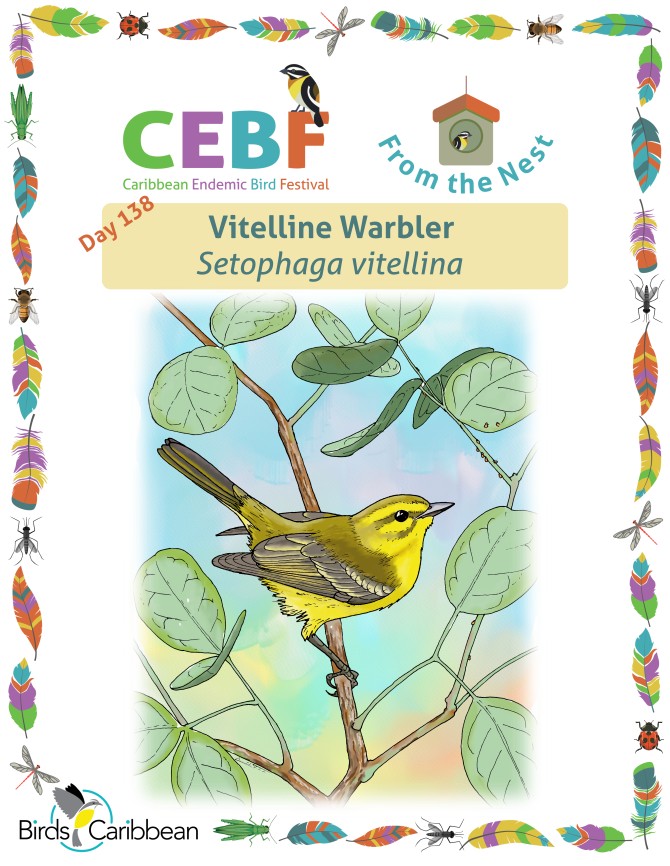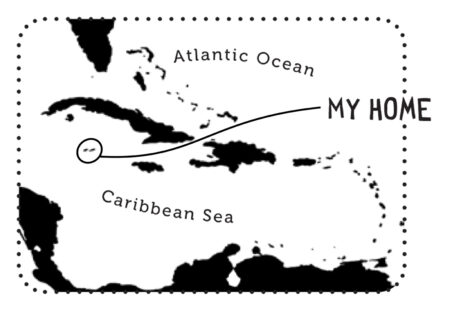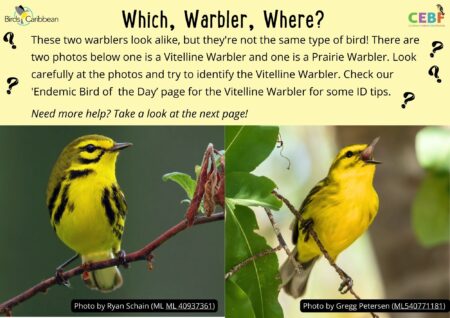Celebrate the Caribbean Endemic Bird Festival (CEBF) with us! Our theme in 2024 is “Protect Insects, Protect Birds”—highlighting the importance of protecting insects for birds and our environment. Have fun learning about a new endemic bird every day. We have colouring pages, puzzles, activities, and more. Download for free and enjoy learning about and celebrating nature!
Endemic Bird of the Day: Vitelline Warbler
Introducing the Vitelline Warbler! If you’re from the Cayman Islands you may know it as “Chip chip.” This little gem might be small, but it’s got some fascinating facts up its wing. Found only in the Cayman Islands and Swan Islands, there are not one, not two, but three wonderful sub-species of Vitelline Warbler! Each one has its own unique flair, adding even more color to these islands’ ecosystems. Spot the S. v. nelson subspecies on the Swan Islands, S. v. vitellina on Grand Cayman, and S. v. crawfordi on Little Cayman & Cayman Brac.
Spotting a Vitelline Warbler can be a treat—here’s what to look for! A small songbird measuring around 4 to 5 inches (10 to 13 centimeters) in length, males sport an olive-green crown and upperparts, and median wing coverts edged yellow with greater wing coverts edged olive-yellow, forming two wing bars. The wings and tail are dusty olive, the head is bright yellow with an olive-green eye-line, and a moustachial stripe that curves below the eye (similar to that of a Prairie Warbler). Underparts are yellow, the sides and flanks are a washed olive color and faintly streaked (not visible during winter). Females are similarly colored but tend to be more dull with less distinctive face markings. The Vitelline Warbler has a pointed bill, perfect for hunting insects.
These birds are not really city birds, and instead prefer the peace and quiet of their leafy homes. If you’re looking for a Vitelline Warbler, head to the thick, dry shrublands, woodlands, and forest edges. Keep your eyes peeled though, these birds are like the ninjas of the forest! Their olive-green color helps them blend in perfectly with the foliage, making them tricky to spot.
What’s on the menu for these little guys? Bugs, bugs, and more bugs! They’re insectivores, gobbling up all sorts of creepy crawlies they find in the foliage. They occasionally consume nectar.
Despite their diminutive size, Vitelline Warblers have giant voices! The sweet melody of their songs echoes through the forest. Listen for a buzz with three brief introductory notes followed by a longer ascending note, and then a long descending note: dzz-dzz-dzz-zzzzii-zzzzuu. They use 3 varieties of these chirps and trills, perfect for serenading potential mates or just chatting with their pals.
When it’s time to settle down and start a family, these warblers get busy! The female builds a cozy little nest resembling a small deep woven cup made from grass, cotton, bromeliads, spider webs, and feathers. These nests are very well hidden by leaves and vines. Mama warbler lays her eggs, usually a small clutch of two eggs, and both parents take turns keeping them warm until they hatch.
The Vitelline Warbler is listed as a restricted range species and faces several threats that have contributed to its classification as “Near Threatened” by the IUCN. As human populations expand and develop, the natural habitats of the Vitelline Warbler on the Cayman Islands are shrinking, leaving them with less space to live, breed, and find food. You can help protect their habitats by supporting local environmental NGOs that are working to prevent urban sprawl and restore natural areas.
Learn more about this species, including its range, photos, and calls here. Great news! If you’re in the Caribbean, thanks to BirdsCaribbean, you have free access to Birds of the World and you can find out even more in the full species account of this bird!
Thanks to Arnaldo Toledo for the illustration and Kelsey-Rae Smith for the text!
Colour in the Vitelline Warbler
Download our West Indies Endemic Bird colouring page. Use the photos below as your guide, or you can look up pictures of the bird online or in a bird field guide if you have one. Share your coloured-in page with us by posting it online and tagging us @BirdsCaribbean #CEBFfromthenest
Listen to the song of the Vitelline Warbler
The song of the Vitelline Warbler is made up of 4-5 harsh, slurred acsending and descending notes “szwee-szwee-szwee-zee” .
Puzzle of the Day
Click on the image below to do the puzzle. You can make the puzzle as easy or as hard as you like – for example, 6, 8, or 12 pieces for young children, all the way up to 1,024 pieces for those that are up for a challenge!
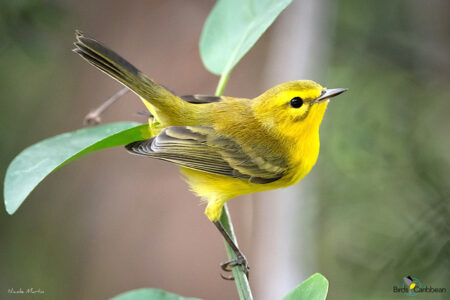
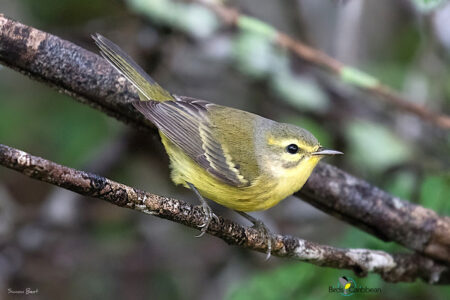
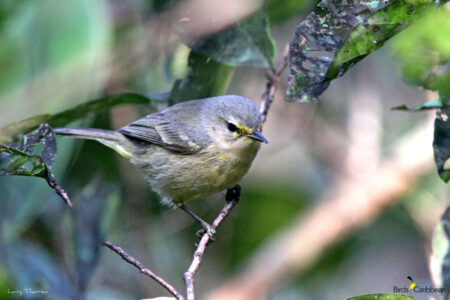
Activity of the Day
FOR KIDS : There are two warblers who can both be found in the Cayman Islands and look very much alike, but they’re not the same type of bird! Once is today’s endemic bird, the Vitelline Warbler, and the other is a Prairie Warbler. Both are mainly olive-coloured and yellow! In our activity of the day you need to look carefully at two photos and try to identify the Vitelline Warbler. Check the text above for some handy tips.
If you get stuck and feel like you need a bit of extra help then take a look on the second page of this activity. You will find some helpful hints to set you on the right track.
Think that you found the Vitelline Warbler? You can check if you are right on our answer sheet here. This activity is perfect to play with school groups or outdoor education clubs etc.
FOR KIDS AND ADULTS : Enjoy this video of a Vitelline Warbler in the wild!

